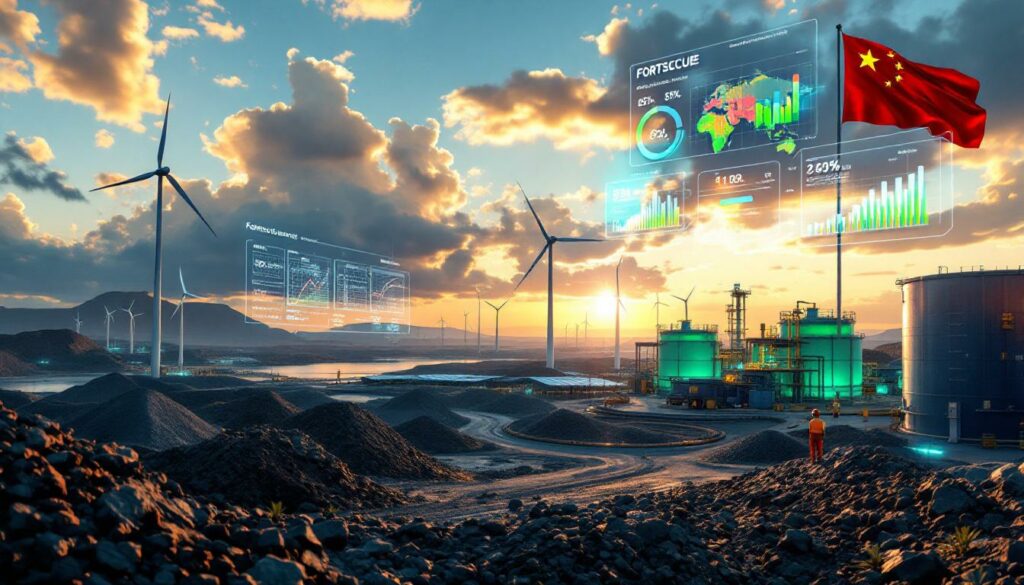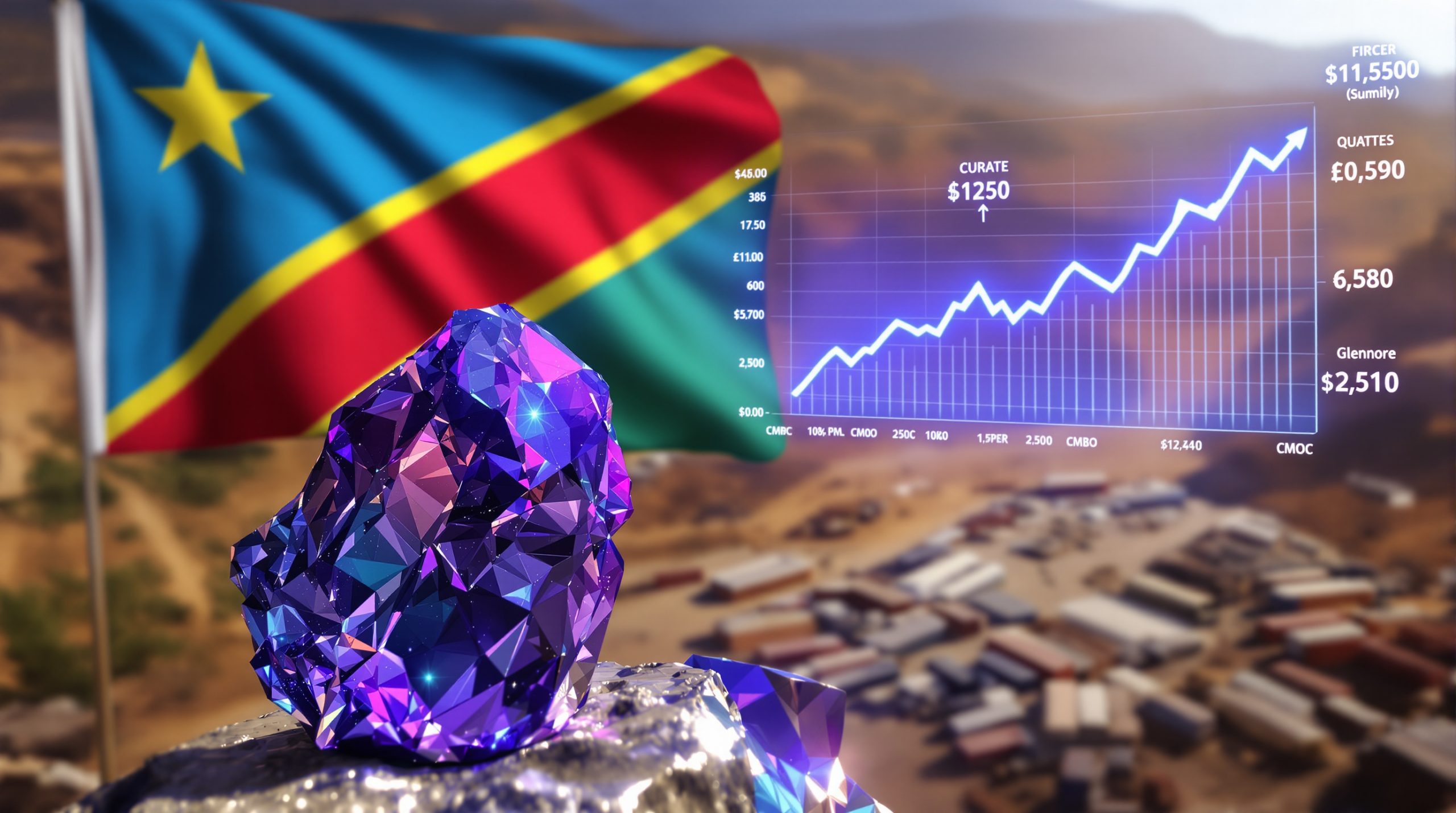Fortescue's $2 Billion Green Financing: Advancing Decarbonization Despite Hydrogen Setbacks
Fortescue, a major Australian mining company, has secured a substantial green financing deal to support its ambitious electrification initiatives and decarbonization initiatives, even as it adjusts its hydrogen production strategy. This development represents a significant milestone in the mining industry's transition toward more sustainable operations and highlights the growing importance of green finance in resource-intensive sectors.
What is Fortescue's New Green Financing Deal?
Details of the $1.98 Billion Loan Facility
Fortescue has successfully secured a 14.2 billion Chinese yuan ($1.98 billion) syndicated term loan facility, according to Reuters reporting via Mining.com on August 7, 2025. This substantial financing package brings together a diverse coalition of financial institutions, with participation from leading Chinese, Australian, and international lenders, though specific lender names were not disclosed in the announcement.
The scale of this green financing deal is particularly noteworthy within the mining sector, where sustainability-linked loans of this magnitude remain relatively uncommon. By securing nearly $2 billion in dedicated green financing, Fortescue is positioning itself as a frontrunner in the industry's decarbonization efforts.
Strategic Timing and Market Context
The timing of this announcement carries particular significance, coming amid evolving global dynamics in green technology investments. The loan facility was secured in August 2025, following Fortescue's July 2025 announcement about scaling back certain hydrogen projects in its portfolio.
This sequencing suggests that despite adjustments to specific hydrogen initiatives, investor confidence in Fortescue's broader decarbonization strategy remains strong. The loan facility demonstrates that financial institutions continue to view Fortescue's green transition as viable and worthy of substantial capital commitment, even as the company refines its approach to hydrogen production.
Executive Chairman Andrew Forrest highlighted international dimensions of this financing in a statement: "As the United States steps back from investing in what will be the world's greatest industry, China and Fortescue are advancing the green technology needed to lead the global energy transition trends."
How is Fortescue Reshaping its Green Strategy?
Recent Strategic Pivots in Hydrogen Projects
July 2025 marked a significant strategic adjustment for Fortescue as the company announced it would scale back several hydrogen projects that had previously been central to its green energy ambitions. Most notably, the company is scrapping planned projects in both the United States and Australia.
The Arizona Hydrogen Project in the United States and the PEM50 Project in Gladstone, Australia, are both being reassessed. According to company statements, Fortescue is currently "assessing options to repurpose the assets and land" associated with these projects, suggesting a potential pivot toward alternative uses rather than a complete abandonment of the infrastructure investments already made.
These adjustments come with financial implications. The company has indicated it expects a preliminary pre-tax writedown of approximately $150 million to be reflected in its H2 results, representing the accounting impact of these strategic shifts.
Revised Green Hydrogen Production Targets
Fortescue had previously set an ambitious target to produce 15 million metric tons of green hydrogen by 2030, positioning itself as a potential global leader in this emerging clean energy sector. However, in July 2024, the company acknowledged that Fortescue Energy was unlikely to meet this target.
This recalibration reflects the complex realities of scaling green hydrogen production, which faces challenges including:
- High production costs relative to conventional hydrogen
- Infrastructure limitations for storage and transport
- Variable renewable energy availability for electrolysis
- Evolving regulatory frameworks and incentive structures
- Market demand uncertainties in a nascent industry
Rather than abandoning its hydrogen ambitions entirely, Fortescue appears to be refocusing its resources on the most viable decarbonization pathways, potentially prioritizing projects with clearer economic returns and technological feasibility in the near term.
Why is This Loan Significant for the Mining Industry?
Pioneering Green Finance in Mining
The $1.98 billion green financing secured by Fortescue represents a landmark development for the mining sector, which has traditionally faced challenges in accessing dedicated sustainability-linked financing at this scale. The successful syndication of this loan facility demonstrates growing financial institution confidence in the mining industry's capacity for meaningful decarbonization.
This financing package creates an important precedent for other mining companies seeking to fund their own sustainability transitions. By successfully securing nearly $2 billion specifically earmarked for green initiatives, Fortescue has helped establish a pathway that peer companies might follow to access similar capital pools.
The deal also highlights the increasing importance of strong environmental, social, and governance (ESG) credentials in securing competitive financing. Mining companies with credible decarbonization strategies may now find themselves at an advantage when approaching capital markets, as Fortescue's success demonstrates that substantial green financing is available to industry leaders.
International Financial Collaboration
A particularly notable aspect of this financing package is its international character, bringing together lenders from multiple countries in support of mining sector decarbonization. The participation of Chinese financial institutions alongside Australian and international lenders underscores the global nature of green finance and climate initiatives.
This cross-border financial collaboration aligns with Fortescue's broader strategic positioning. As a major iron ore supplier to China, the company has leveraged its existing commercial relationships to advance its sustainability agenda. This approach creates potential synergies between traditional resource trade relationships and emerging green finance opportunities.
The international dimension of this financing also highlights how decarbonization initiatives can strengthen economic ties between countries. In this case, the Australia-China economic relationship, anchored in resource trade, is evolving to encompass shared interests in green technology development and climate finance.
What is Fortescue's Position in the Green Industrial Revolution?
Andrew Forrest's Vision and Leadership
Executive Chairman Andrew Forrest has consistently positioned Fortescue at the forefront of mining's green transition. His leadership approach emphasizes first-mover advantage in sustainability initiatives and frames decarbonization not merely as a compliance requirement but as a strategic business opportunity.
Forrest's public statements reflect this positioning. In discussing the recent financing, he explicitly framed Fortescue's partnership with China as advancing "the green technology needed to lead the global green industrial revolution," positioning the company as a pioneering force rather than a follower in the industry innovation trends.
Notably, Forrest has contrasted Fortescue's approach with what he characterizes as a U.S. pullback from green investments. This framing positions Fortescue's strategy as countercyclical to perceived trends in some markets and emphasizes the company's willingness to maintain its decarbonization momentum even amid shifting global investment patterns.
Fortescue's Role as Iron Ore Supplier to China
Fortescue's established position as "a major iron ore supplier to China" provides important context for understanding its green financing success. This existing commercial relationship likely facilitated the participation of Chinese financial institutions in the loan syndication and demonstrates how traditional resource trade relationships can evolve to encompass sustainability initiatives.
The company appears to be leveraging these established trade relationships to advance its green agenda, creating potential synergies between its core mining business and emerging sustainability initiatives. This approach could create competitive advantages in both securing financing and developing market positioning for lower-carbon mining products.
By strengthening Australia-China economic ties through sustainable development initiatives, Fortescue is potentially insulating its core business relationships against geopolitical uncertainties while simultaneously advancing its decarbonization agenda.
What Challenges Does Fortescue Face in its Green Transition?
Financial Implications of Project Adjustments
The $150 million writedown associated with Fortescue's hydrogen project adjustments signals the financial costs of strategic pivots in the decarbonization journey. Managing these costs while maintaining shareholder returns represents a significant challenge for the company as it navigates its green transition.
Balancing ambitious decarbonization goals with financial prudence requires careful calibration. The company must determine which green investments offer the most favorable risk-return profiles and sequence its capital deployment accordingly. The recent financing success suggests that external capital providers maintain confidence in Fortescue's ability to strike this balance effectively.
Managing investor expectations during this transition period represents another challenge. As the company adjusts specific project timelines and targets, it must communicate a compelling narrative about its overarching decarbonization strategy to maintain market confidence and support its valuation.
Technical and Operational Hurdles
Scaling green hydrogen production faces substantial technological barriers that have likely contributed to Fortescue's strategic adjustments. These include challenges in electrolysis efficiency, renewable energy integration, and hydrogen storage and transport infrastructure.
The company also faces significant infrastructure development needs for its new energy initiatives. Building the physical assets required for large-scale decarbonization—from renewable energy generation to green hydrogen production facilities—requires substantial capital, specialized expertise, and extended timeframes.
Integration challenges between traditional mining operations and green energy initiatives represent another hurdle. Fortescue must determine how to effectively incorporate new technologies and processes into existing operations while maintaining production efficiency and cost competitiveness.
How Does This Compare to Other Mining Companies' Decarbonization Efforts?
Industry Benchmarking and Leadership Position
Fortescue's $1.98 billion green financing package stands out for its scale within the mining sector. While many mining companies have announced sustainability initiatives, few have secured dedicated green financing of this magnitude, positioning Fortescue as a financial innovator in the industry's decarbonization journey.
The company's willingness to make early and substantial investments in green technologies, despite the associated risks and adjustments, contrasts with more conservative approaches adopted by some industry peers. This more aggressive stance on decarbonization could establish competitive advantages if regulatory pressures and market premiums for lower-carbon products increase as expected.
However, Fortescue's recent strategic adjustments to its hydrogen targets also highlight the challenges of maintaining an ambitious decarbonization timeline. The company's experience demonstrates that even industry leaders must remain flexible and pragmatic in their approach to new technologies and production methods.
Market Differentiation Strategy
Fortescue appears to be positioning itself as a premium sustainable mining company, potentially allowing it to appeal to ESG-focused investors and customers. This differentiation strategy could yield benefits in both capital markets and product markets if sustainability credentials become increasingly important to stakeholders.
The company's substantial investments in decarbonization could create the foundation for potential price premiums for "greener" iron ore in the future. As customers face increasing pressure to reduce scope 3 emissions in their supply chains, suppliers with lower carbon footprints may command market advantages.
These investments also build resilience against future carbon pricing and regulations. By accelerating its decarbonization efforts now, Fortescue is potentially reducing its exposure to regulatory risks and carbon pricing mechanisms that could impact less proactive competitors more severely in the future.
What Are the Implications for Australia's Mining Sector?
National Economic Impact
Fortescue's leadership in green mining practices could strengthen Australia's position in the global resources sector as markets increasingly prioritize lower-carbon products. By pioneering decarbonization at scale, the company is helping establish Australia as a potential leader in sustainable resource production.
The company's initiatives may create technology spillovers to other Australian miners. Innovations developed or scaled by Fortescue could ultimately benefit the broader Australian mining sector, potentially accelerating industry-wide adoption of effective decarbonization approaches.
Fortescue's green transition also supports Australia's jobs transition from traditional to green mining operations. As the company develops expertise in renewable energy integration, electrification, and potentially hydrogen applications, it is creating employment opportunities in emerging green technology fields within the mining context.
Regulatory and Policy Context
Fortescue's decarbonization initiatives align with Australia's emissions reduction commitments, demonstrating how private sector leadership can advance national climate objectives. The company's proactive stance potentially reduces pressure for more stringent regulatory interventions by showing that voluntary corporate action can drive meaningful emissions reductions.
The company's success in securing international green financing may influence future government support mechanisms for mining decarbonization. Policymakers may look to Fortescue's experience to inform how public financing and incentives can most effectively complement private capital in accelerating the sector's green transition.
Fortescue's collaboration with Chinese financial institutions on green initiatives also showcases Australia-China cooperation on sustainable development, potentially creating a model for how resource trade relationships can evolve to encompass shared climate objectives despite broader geopolitical complexities.
What's Next for Fortescue's Green Initiatives?
Future Investment Priorities
Following its strategic adjustments to hydrogen projects, Fortescue is likely to focus on the most economically viable decarbonization technologies. This may include prioritizing initiatives with clearer near-term returns on investment and more established technological pathways.
The company may accelerate electrification across its mining operations as a core decarbonization strategy. Electric mining equipment, renewable energy generation for operational power needs, and battery storage integration represent potentially high-impact focus areas with relatively mature technological foundations.
While scaling back certain hydrogen ambitions, Fortescue will likely continue more selective investments in hydrogen applications, particularly those with clear use cases within its own operations. This could include hydrogen-powered heavy equipment or process heat applications where electrification proves more challenging.
Timeline for Implementation
Fortescue will likely focus on completing projects funded by the new $1.98 billion green financing package over the next 2-3 years, with most initiatives targeted for completion by 2026-2027. This near-term focus will allow the company to demonstrate tangible progress to investors and lenders while building institutional knowledge for future decarbonization phases.
Medium-term goals for operational emissions reductions by 2030 remain a priority, even as specific hydrogen production targets have been adjusted. The company is likely to maintain its focus on substantial emissions reductions within this timeframe while allowing greater flexibility in the specific technological pathways to achieve these outcomes.
Fortescue's long-term vision for carbon neutrality across all operations continues to guide its strategy, even as it adjusts specific project timelines and approaches. The recent financing success suggests that this overarching vision remains credible to capital providers despite tactical adjustments along the way.
FAQ: Fortescue's Green Financing and Decarbonization
How will the $1.98 billion loan specifically be used?
The loan will fund Fortescue's decarbonization initiatives across multiple domains. While specific allocation details weren't disclosed in the announcement, likely focus areas include renewable energy infrastructure to power mining operations, fleet electrification to reduce diesel consumption, energy efficiency improvements across existing facilities, and continued development of viable hydrogen applications where economically feasible.
Why is Fortescue scaling back hydrogen projects?
Fortescue is adjusting its hydrogen strategy due to a combination of factors including technological challenges in scaling production, economic considerations regarding production costs versus potential returns, and logistical hurdles in transportation and storage infrastructure. Rather than abandoning hydrogen entirely, the company appears to be focusing on more immediately viable decarbonization pathways while maintaining selective hydrogen investments where use cases are clearest.
What role does China play in Fortescue's green strategy?
China serves dual roles in Fortescue's green strategy. First, as "a major iron ore supplier to China," Fortescue maintains strong commercial relationships that provide financial stability and market access. Second, Chinese financial institutions are participating significantly in Fortescue's recent $1.98 billion green loan facility, demonstrating how these commercial relationships are evolving to encompass sustainability initiatives and green finance.
How does this loan affect Fortescue's financial outlook?
While adding to Fortescue's debt load, the green loan represents strategic investment in future-proofing operations against increasingly stringent climate regulations and potential carbon pricing mechanisms. The financing may also support the development of premium "green" products that could command higher market prices as customers increasingly prioritize scope 3 emissions reductions. The expected long-term positive impact on financial performance must be balanced against short-term costs, including the $150 million writedown associated with hydrogen project adjustments.
What makes Fortescue's approach to decarbonization unique?
Fortescue stands out for several distinguishing factors in its decarbonization approach. The scale of its financial commitment is exceptional within the mining sector, as demonstrated by the $1.98 billion green loan facility. The company has shown willingness to pioneer new technologies even when this entails risk and potential adjustment, as seen in its early ambitious hydrogen targets. Executive Chairman Andrew Forrest's personal commitment to positioning the company as a leader in the "green industrial revolution" provides strong leadership continuity for these initiatives, even amid strategic adjustments to specific projects and participation in the upcoming mining innovation expo.
Furthermore, Fortescue continues to explore new investment opportunities in the green technology space, diversifying its portfolio beyond traditional mining operations.
Disclaimer: This article contains forward-looking statements about Fortescue's decarbonization strategy and green financing initiatives. Future results may differ materially from these projections due to technological developments, market conditions, regulatory changes, and other factors affecting the mining and energy sectors. Readers should not base investment decisions solely on the information provided here.
Looking to Discover the Next Major ASX Mining Opportunity?
Stay ahead of the market with Discovery Alert's proprietary Discovery IQ model, which instantly notifies investors of significant ASX mineral discoveries and turns complex data into actionable insights. Explore why major discoveries can lead to substantial returns by visiting our dedicated discoveries page and start your 30-day free trial today.




